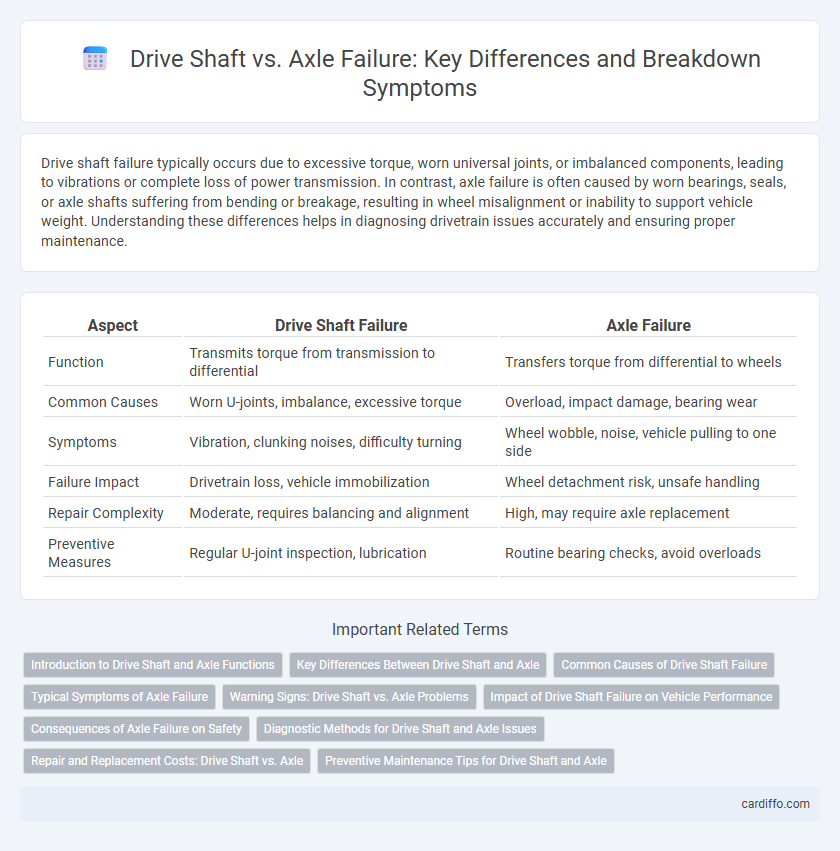Drive shaft failure typically occurs due to excessive torque, worn universal joints, or imbalanced components, leading to vibrations or complete loss of power transmission. In contrast, axle failure is often caused by worn bearings, seals, or axle shafts suffering from bending or breakage, resulting in wheel misalignment or inability to support vehicle weight. Understanding these differences helps in diagnosing drivetrain issues accurately and ensuring proper maintenance.
Table of Comparison
| Aspect | Drive Shaft Failure | Axle Failure |
|---|---|---|
| Function | Transmits torque from transmission to differential | Transfers torque from differential to wheels |
| Common Causes | Worn U-joints, imbalance, excessive torque | Overload, impact damage, bearing wear |
| Symptoms | Vibration, clunking noises, difficulty turning | Wheel wobble, noise, vehicle pulling to one side |
| Failure Impact | Drivetrain loss, vehicle immobilization | Wheel detachment risk, unsafe handling |
| Repair Complexity | Moderate, requires balancing and alignment | High, may require axle replacement |
| Preventive Measures | Regular U-joint inspection, lubrication | Routine bearing checks, avoid overloads |
Introduction to Drive Shaft and Axle Functions
The drive shaft transmits torque from the engine to the wheels, enabling vehicle movement, while the axle supports the vehicle's weight and maintains wheel alignment. These components are critical in power delivery and vehicle stability, with the drive shaft typically enduring rotational stress and the axle handling both rotational forces and vertical load. Understanding their distinct functions helps diagnose failures that result in breakdowns, such as vibrations from a damaged drive shaft or axle bending causing wheel misalignment.
Key Differences Between Drive Shaft and Axle
The drive shaft transmits torque from the engine or transmission to the wheels, enabling vehicle movement, whereas the axle primarily supports the vehicle's weight and serves as a mounting point for the wheels. Drive shaft failure often results in vibration, clunking noises, or loss of power delivery, while axle failure typically causes wheel misalignment, uneven tire wear, or difficulty steering. Understanding these functional differences helps in diagnosing issues, as drive shafts deal with rotational power transfer while axles bear structural loads and maintain wheel positioning.
Common Causes of Drive Shaft Failure
Common causes of drive shaft failure include worn-out universal joints, imbalanced shafts, and damaged CV joints, which can lead to vibrations and eventual breakdowns. Lack of proper lubrication and excessive torque can accelerate wear and cause cracks or bends in the drive shaft. Regular inspection and maintenance help prevent these issues, ensuring reliable vehicle operation and reducing the risk of axle-related failures.
Typical Symptoms of Axle Failure
Typical symptoms of axle failure include clicking or popping noises when turning, vibration or shuddering during acceleration, and grease leakage near the wheel area. A damaged CV joint often causes these symptoms, leading to compromised vehicle stability and steering control. Prompt diagnosis and replacement of a failing axle are crucial to prevent further drivetrain damage and ensure safe driving conditions.
Warning Signs: Drive Shaft vs. Axle Problems
Vibrations during acceleration, clunking noises, and difficulty turning are common warning signs of a failing drive shaft, indicating issues with CV joints or universal joints. Axle problems typically present as leaking grease, clicking sounds when turning, and uneven tire wear, signaling worn or damaged axle components. Early detection of these symptoms is crucial to prevent breakdowns and costly repairs.
Impact of Drive Shaft Failure on Vehicle Performance
Drive shaft failure severely compromises vehicle performance by disrupting power transmission from the engine to the wheels, leading to reduced acceleration and unstable handling. This failure can cause vibrations, noises, and potential loss of control, increasing the risk of accidents. Unlike axle failure, which primarily affects wheel rotation, drive shaft issues directly hinder drivetrain efficiency and overall vehicle dynamics.
Consequences of Axle Failure on Safety
Axle failure critically compromises vehicle stability, increasing the risk of loss of control and severe accidents. Unlike drive shaft issues, axle failure directly affects wheel alignment and load distribution, leading to potential wheel detachment. Immediate repair is essential to prevent hazardous situations, ensuring passenger safety and vehicle operability.
Diagnostic Methods for Drive Shaft and Axle Issues
Diagnosing drive shaft failures involves inspecting for vibrations, unusual noises, and checking for worn universal joints or damaged CV joints using a vibration analyzer and physical examination. Axle issues are typically diagnosed through visual inspection for leaks, bends, or cracks, and by performing wheel play tests and road tests to detect irregular movement or noise. Advanced diagnostic methods include using computerized wheel alignment tools and onboard diagnostic scanners to pinpoint sensor faults or imbalance in both drive shafts and axles.
Repair and Replacement Costs: Drive Shaft vs. Axle
Drive shaft repair costs typically range from $300 to $500, while axle replacement can cost between $400 and $800 depending on the vehicle model and damage severity. Drive shaft issues often require less labor-intensive repairs, making them generally more affordable, whereas axle failures frequently demand more extensive work, such as suspension component replacement. Choosing repair versus replacement costs depends on the extent of wear, with drive shafts sometimes repaired by balancing or joint replacement, while axles often necessitate full replacement due to structural damage.
Preventive Maintenance Tips for Drive Shaft and Axle
Regularly inspect the drive shaft and axle for signs of wear, such as cracks, rust, or unusual vibrations to prevent breakdowns. Lubricate universal joints and check CV joint boots for tears or leaks to ensure smooth operation and extend component lifespan. Tighten mounting bolts and replace damaged seals promptly to avoid costly repairs and maintain vehicle safety.
Drive shaft vs axle failure Infographic

 cardiffo.com
cardiffo.com